Autonomous driving chip research: In addition to computing power, core IP, software stacks, AI training platforms, etc. are becoming more and more important
L2.5 and L2.9 have achieved mass production for vehicles running on the road, and mass production of L3 and L4 in limited scenarios has become a goal for OEMs in the next stage. In March 2022, the U.S. National Highway Traffic Safety Administration (NHTSA) issued final rules eliminating the need for automated vehicle manufacturers to equip fully autonomous vehicles with manual driving controls to meet crash standards. The United States is expected to introduce more important policies for autonomous driving in the future to guide L3/L4 autonomous driving on the road.
In this context, ADAS/autonomous driving chips have seen a wave of upgrades, and many chip makers have launched or planned to unveil high computing power chips. In January 2022, Mobileye introduced the EyeQ? Ultra?, the company’s most advanced, highest performing system-on-chip (SoC) purpose-built for autonomous driving. As unveiled during CES 2022, EyeQ Ultra maximizes both effectiveness and efficiency at only 176 TOPS, with 5 nanometer process technology. Although it looks less potent than chips from rivals Qualcomm and NVIDIA, the cost-effective and high-energy-efficiency EyeQ? Ultra? may still be favored by OEMs.
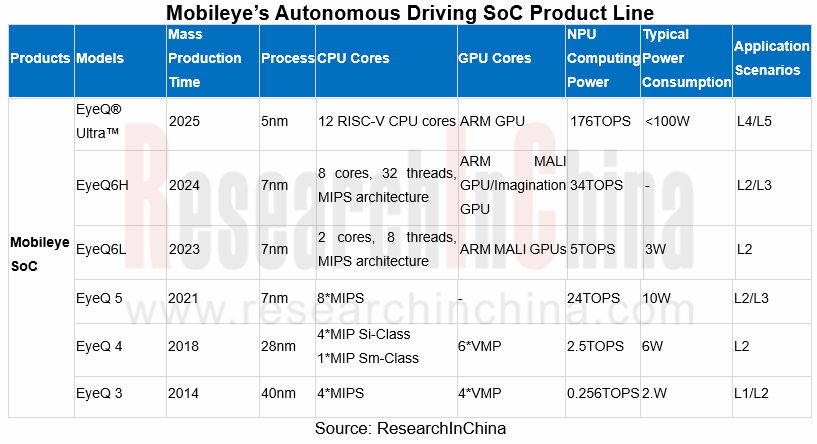
In addition to computing power, self-developed core IP is the focus of competition for major SoC vendors
SoC chips, which are mostly involved with heterogeneous design, include different computing units such as GPU, CPU, acceleration core, NPU, DPU, ISP, etc. Generally speaking, computing power cannot be simply evaluated from the chip alone. Chip bandwidth, peripherals, memory, as well as energy efficiency ratio and cost should be also taken into account. At the same time, the development tool chain of SoC chips is very important. Only by forming a developer ecosystem can a company build long-term sustainable competitiveness.
In chip design, the configuration of heterogeneous IP is crucial, and autonomous driving SoC chip vendors are constantly strengthening the research and development of core IP to maintain their decisive competitive edges. For example, NVIDIA upgraded its existing GPU-based product line to a three-chip (GPU+CPU+DPU) strategy:
? GPU: NVIDIA enjoys superiority in GPU and image processing derived from GPU;
? DPU: NVIDIA announced the completion of its acquisition of Mellanox Technologies, Ltd., an Israeli chip company, for a transaction value of $7 billion and launched the BlueField?-3 data processing unit (DPU). DPU is a programmable electronic component with the versatility and programmability of a central processing unit (CPU), dedicated to efficiently handling network data packets, storage requests or analysis requests;
? In terms of CPU, NVIDIA intended to acquire the semiconductor IP semiconductor ARM as an extension of its three-chip strategy, but it failed in the end. However, NVIDIA launched the Grace? CPU, an Arm-based processor that will deliver 10x the performance of today’s fastest servers on the most complex AI and high-performance computing workloads. NVIDIA's next-generation SOC, Atlan, is based on the ARM-based Grace CPU and Ampere Next GPU.

In terms of domestic vendors, Black Sesame Technologies has launched self-developed NeuralIQ ISP and DynamAI NN engine which is a deep neural network algorithm platform.
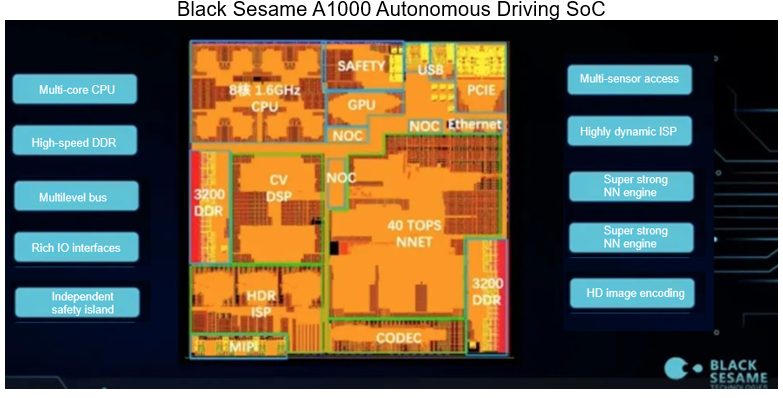
Cross-domain fusion and central computing platform chips will lead the evolution of the automotive EEA
Amid the evolution trend of the automotive EEA: "distributed architecture - domain centralized architecture - cross-domain fusion architecture - central computing platform", Tesla's latest version of Model X has achieved a certain degree of central cross-domain fusion computing. Model X's automotive central computing platform includes two FSD chips, an AMD Ryzen CPU chip and an AMD RDNA2 GPU. The FSD chip and AMD CPU/GPU chip communicate through the PCIe interface and are isolated from each other.
Integrating multiple chips such as CPU, GPU, and FSD into one SoC chip through Chiplet technology will further reduce the chip communication delay. Tesla has reportedly partnered with Samsung on a new 5nm chip for autonomous driving and cockpit SoC chip integration.
The industry’s giants like NVIDIA and Qualcomm have all begun to implement cross-domain integration of autonomous driving and cockpits. For example, NVIDIA has launched DRIVE Concierge and DRIVE Chauffeur for smart cockpits and autonomous driving respectively. DRIVE IX can realize the fusion of algorithms in the cockpit. Based on the powerful software stack tools, NVIDIA's next-generation Ampere architecture (Atlan SoC) will conduct the simultaneous control over autonomous driving and intelligent cockpit with a single chip.
In February 2022, Chinese SoC company Horizon Robotics announced that it will cooperate with UAES to preinstall and mass-produce cross-domain integrated automotive computing platforms.
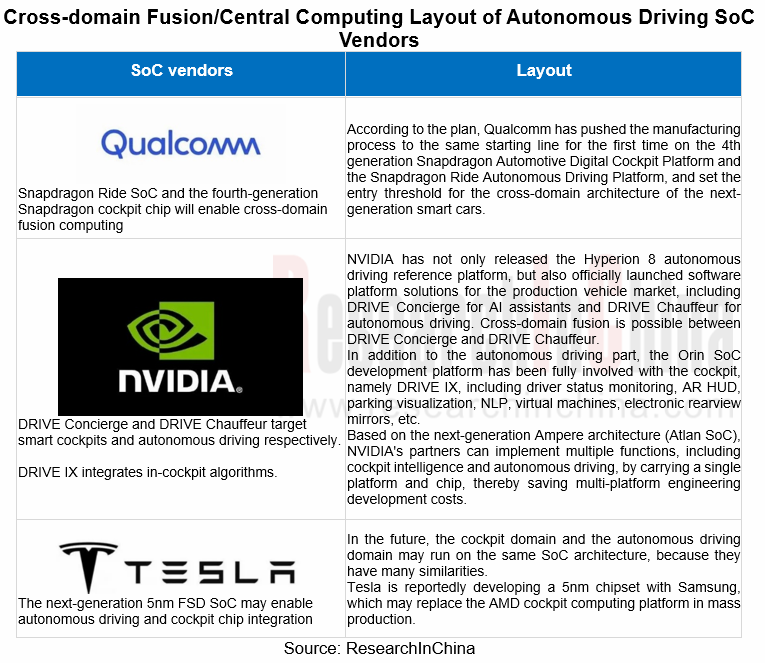
SoC vendors accelerate the layout of autonomous driving AI data training
Autonomous driving datasets are critical for training deep learning models and improving algorithm reliability. SoC vendors have launched self-developed AI training chips and supercomputing platforms. Tesla has launched the AI training chip D1 and the "Dojo" supercomputing platform, which will be used for the training of Tesla's autonomous driving neural network.
Besides, training algorithm models are becoming more and more important, including 2D annotation, 3D point cloud annotation, 2D/3D fusion annotation, semantic segmentation, target tracking, etc., such as the NVIDIA Drive Sim autonomous driving simulation platform, the Horizon Robotics "Eddie" data closed loop training platform, etc.
Foreign chip vendors:
? Tesla has launched Dojo supercomputing training platform, using Tesla's self-developed 7nm AI training chip D1 and relying on a huge customer base to collect autonomous driving data, so as to achieve model training for deep learning systems. At present, Tesla Autopilot mainly uses 2D images + annotations for training and algorithm iteration. Through the Dojo supercomputing platform, Autopilot can fulfill training through 3D images + time stamps (4D Autopilot system). The 4D Autopilot system will be predictable, and mark the 3D movement trajectory of road objects to enhance the reliability of autonomous driving functions.
? NVIDIA has announced NVIDIA Omniverse Replicator, an engine for generating synthetic data with ground truth for training AI networks. NVIDIA also has the most powerful training processor - the NVIDIA A100.
? The map data of Mobileye's REM has covered the world. In China, Mobileye has solved the compliance problem of map data collection in China through a joint venture with Tsinghua Unigroup. Intel acquired Moovit to enhance the strength and data differentiation of REM, extend the traditional HD map data from the roadside to the user side, start from the perception redundancy of assisted autonomous driving and improve the efficiency of path planning. Intel launched its self-developed flagship AI chip - Ponte Vecchio, which will spread to Mobileye's EyeQ6 (planned for mass production in 2023). In the field of AI and servers, Intel will challenge Nvidia with CO-EMIB technology.
Domestic chip vendors:
? In order to solve the long-tail problem of autonomous driving, Horizon Robotics has built a complete data closed-loop platform to iterate algorithms and improve system capabilities. Horizon Robotics has launched the "Eddie" data closed loop training platform.
? Huawei has introduced "Octopus" autonomous driving open platform, focusing on the four most critical elements of autonomous driving development - hardware, data, algorithms and HD maps to build a data-centric open platform which prompts closed-loop iterations of autonomous driving. Huawei's Ascend 910 competes with the NVIDIA A100 as the world's top AI training chip. Huawei has also launched the AI training cluster Atlas 900.
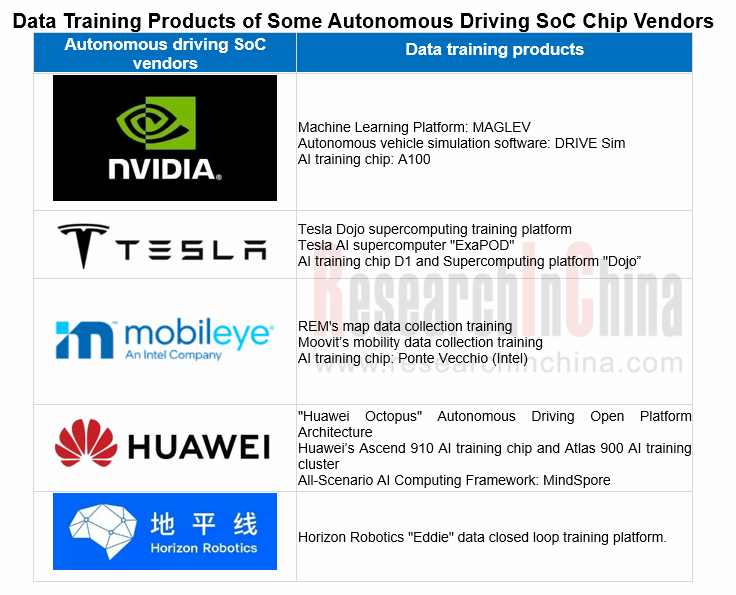
The world's leading autonomous driving AI training chips include: Intel Ponte Vecchio, NVIDIA A100, Tesla D1, Huawei Ascend 910, Google TPU (v1, v2, v3), Cerebras Wafer-Scale Engine, Graphcore IPU, etc.
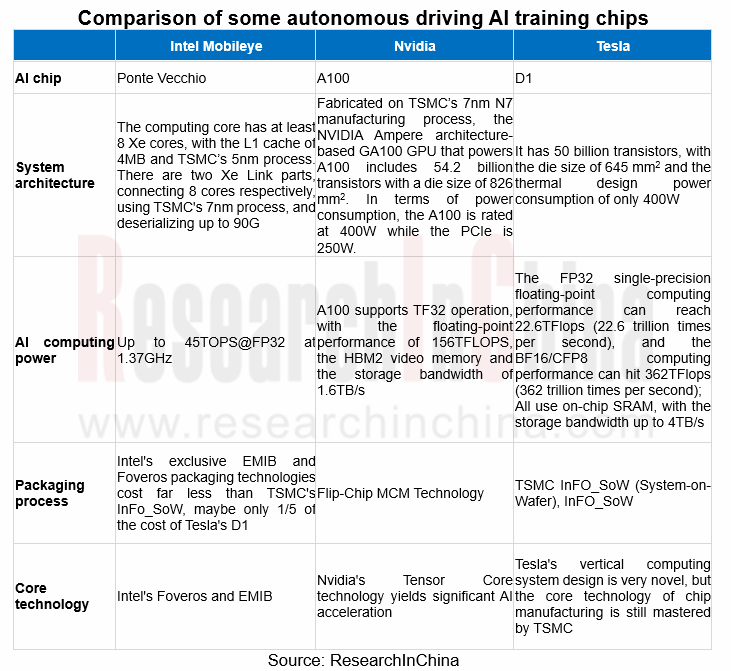
Autonomous Driving Domain Controller and Central Computing Unit (CCU) Industry Report, 2025
Research on Autonomous Driving Domain Controllers: Monthly Penetration Rate Exceeded 30% for the First Time, and 700T+ Ultrahigh-compute Domain Controller Products Are Rapidly Installed in Vehicles
L...
China Automotive Lighting and Ambient Lighting System Research Report, 2025
Automotive Lighting System Research: In 2025H1, Autonomous Driving System (ADS) Marker Lamps Saw an 11-Fold Year-on-Year Growth and the Installation Rate of Automotive LED Lighting Approached 90...
Ecological Domain and Automotive Hardware Expansion Research Report, 2025
ResearchInChina has released the Ecological Domain and Automotive Hardware Expansion Research Report, 2025, which delves into the application of various automotive extended hardware, supplier ecologic...
Automotive Seating Innovation Technology Trend Research Report, 2025
Automotive Seating Research: With Popularization of Comfort Functions, How to Properly "Stack Functions" for Seating?
This report studies the status quo of seating technologies and functions in aspe...
Research Report on Chinese Suppliers’ Overseas Layout of Intelligent Driving, 2025
Research on Overseas Layout of Intelligent Driving: There Are Multiple Challenges in Overseas Layout, and Light-Asset Cooperation with Foreign Suppliers Emerges as the Optimal Solution at Present
20...
High-Voltage Power Supply in New Energy Vehicle (BMS, BDU, Relay, Integrated Battery Box) Research Report, 2025
The high-voltage power supply system is a core component of new energy vehicles. The battery pack serves as the central energy source, with the capacity of power battery affecting the vehicle's range,...
Automotive Radio Frequency System-on-Chip (RF SoC) and Module Research Report, 2025
Automotive RF SoC Research: The Pace of Introducing "Nerve Endings" such as UWB, NTN Satellite Communication, NearLink, and WIFI into Intelligent Vehicles Quickens
RF SoC (Radio Frequency Syst...
Automotive Power Management ICs and Signal Chain Chips Industry Research Report, 2025
Analog chips are used to process continuous analog signals from the natural world, such as light, sound, electricity/magnetism, position/speed/acceleration, and temperature. They are mainly composed o...
Global and China Electronic Rearview Mirror Industry Report, 2025
Based on the installation location, electronic rearview mirrors can be divided into electronic interior rearview mirrors (i.e., streaming media rearview mirrors) and electronic exterior rearview mirro...
Intelligent Cockpit Tier 1 Supplier Research Report, 2025 (Chinese Companies)
Intelligent Cockpit Tier1 Suppliers Research: Emerging AI Cockpit Products Fuel Layout of Full-Scenario Cockpit Ecosystem
This report mainly analyzes the current layout, innovative products, and deve...
Next-generation Central and Zonal Communication Network Topology and Chip Industry Research Report, 2025
The automotive E/E architecture is evolving towards a "central computing + zonal control" architecture, where the central computing platform is responsible for high-computing-power tasks, and zonal co...
Vehicle-road-cloud Integration and C-V2X Industry Research Report, 2025
Vehicle-side C-V2X Application Scenarios: Transition from R16 to R17, Providing a Communication Base for High-level Autonomous Driving, with the C-V2X On-board Explosion Period Approaching
In 2024, t...
Intelligent Cockpit Patent Analysis Report, 2025
Patent Trend: Three Major Directions of Intelligent Cockpits in 2025
This report explores the development trends of cutting-edge intelligent cockpits from the perspective of patents. The research sco...
Smart Car Information Security (Cybersecurity and Data Security) Research Report, 2025
Research on Automotive Information Security: AI Fusion Intelligent Protection and Ecological Collaboration Ensure Cybersecurity and Data Security
At present, what are the security risks faced by inte...
New Energy Vehicle 800-1000V High-Voltage Architecture and Supply Chain Research Report, 2025
Research on 800-1000V Architecture: to be installed in over 7 million vehicles in 2030, marking the arrival of the era of full-domain high voltage and megawatt supercharging.
In 2025, the 800-1000V h...
Foreign Tier 1 ADAS Suppliers Industry Research Report 2025
Research on Overseas Tier 1 ADAS Suppliers: Three Paths for Foreign Enterprises to Transfer to NOA
Foreign Tier 1 ADAS suppliers are obviously lagging behind in the field of NOA.
In 2024, Aptiv (2.6...
VLA Large Model Applications in Automotive and Robotics Research Report, 2025
ResearchInChina releases "VLA Large Model Applications in Automotive and Robotics Research Report, 2025": The report summarizes and analyzes the technical origin, development stages, application cases...
OEMs’ Next-generation In-vehicle Infotainment (IVI) System Trends Report, 2025
ResearchInChina releases the "OEMs’ Next-generation In-vehicle Infotainment (IVI) System Trends Report, 2025", which sorts out iterative development context of mainstream automakers in terms of infota...